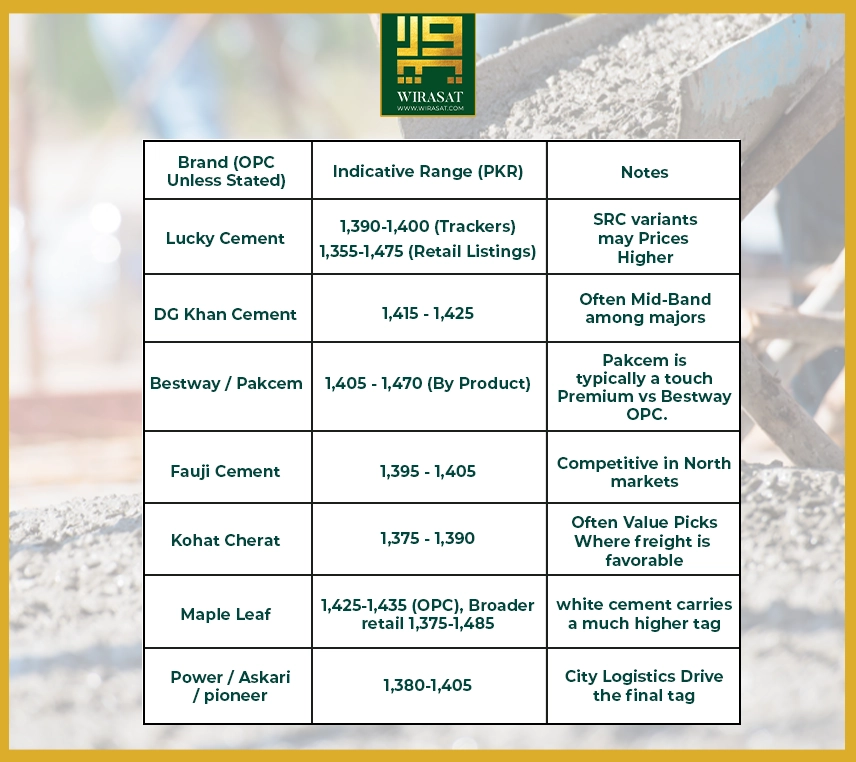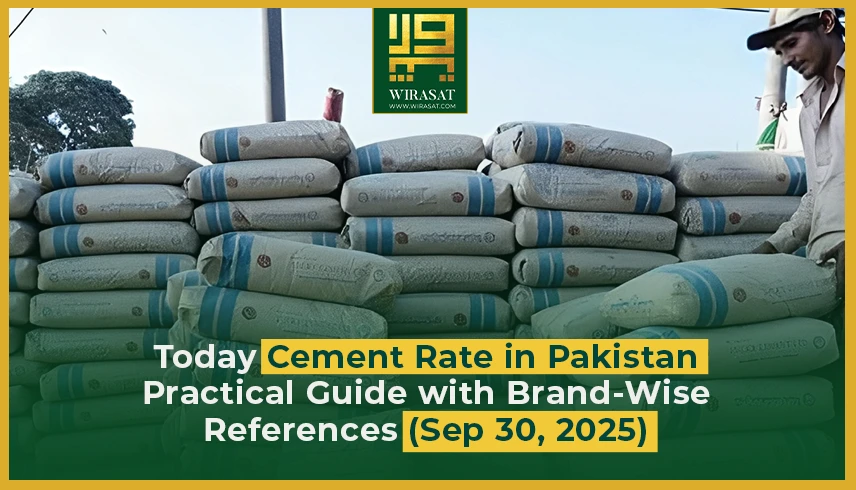Today Cement Rate in Pakistan
Introduction
Construction decisions move on numbers, not guesses. For homeowners planning a grey structure, contractors finalizing BOQs, and developers scheduling pours, understanding the today cement rate in Pakistan is essential. This page explains how prices are formed, where they stand this week, and how to read quotes correctly so budgeting stays disciplined and realistic.
What “today cement price in pakistan today” actually means?
Daily quotes are retail indicators, not universal absolutes. Pakistan’s market reflects mill ex-factory pricing, dealer margins, inter-city freight, payment terms, and local demand spikes. Two buyers can receive different offers on the same day because distance from mill, brand choice (OPC vs SRC), and delivery conditions vary. Treat every quote as city + brand + bag size + delivery basis to make like-for-like comparisons.
Snapshot: where cement prices are trending this week?
Independent market trackers and retailers indicate a typical band for a standard 50 kg bag in late September 2025 sits roughly in the mid-PKR 1,3xx to 1,4xx range depending on brand and city. For example, brand lists published this week place Cherat, Kohat, Lucky and Fauji largely in the PKR 1,375–1,405 zone, with Maple Leaf and Pakcem often a touch higher, aggregated shop listings show overlapping bands by brand and product (OPC/SRC).
For a macro view, Pakistan Bureau of Statistics’ weekly average for a 50 kg bag across urban centers (via Karandaaz) lets you benchmark retail quotes against a national mean and spot trend direction over time. Use it to sanity-check dealer offers.
Important: Always confirm date, city, brand, product (OPC/SRC), and whether the quote is delivered-to-site or ex-warehouse before locking purchase.
Brand-wise reference rates (50 kg) — late Sep 2025
These are indicative retail ranges observed across multiple price trackers and retailer listings. Real quotes may differ by city and freight.
Why ranges? Retail sites list min–max by city, while brand sheets and market posts show point or narrow-band quotes, combining both paints a realistic envelope you can verify locally.

Understanding “Cement ka rate” versus invoice price
People often search Cement ka rate and expect a single number. In practice, the invoice depends on five variables:
- Product type: OPC vs SRC, whereas, white cement is a different market entirely.
- Freight and handling: Distance from mill and last-mile delivery to site.
- Dealer margin and payment terms: Cash vs credit can change the tag.
- Local demand: Peaks during active housing and infrastructure phases.
Packaging and authenticity checks: Proper, sealed, recent-batch bags reduce wastage and disputes.
City-wise nuance: why Karachi, Lahore, Islamabad differ
Major cities show slight spreads because of port costs, distribution networks, and proximity to mills. Karachi quotes can be marginally higher due to port-side handling and urban logistics, however, northern cities often benefit from shorter hauls from nearby plants. Always compare Karachi vs Lahore vs Islamabad on the same brand and same delivery basis to avoid false conclusions. (Cross-check your numbers against a weekly national average for sanity.
How to read and negotiate the cement rate in Pakistan today?
- Standardize the unit: Keep everything in 50 kg terms. If a vendor quotes per ton, convert back to bags (20 bags = 1,000 kg) for clarity.
- Lock short delivery windows: Markets are stable until they are not. Secure supply in tranches that match your pouring schedule.
- Verify authenticity: Batch date, seal integrity, and brand markings matter more than a minor price edge.
- Coordinate with steel and crush: Align deliveries so storage remains dry and safe; moisture ruins value and strength.
- Keep a price log: Record brand, city, basis (ex-warehouse vs delivered), and date. Over a month, your log becomes a reliable internal index against which to test any quote. (Use PBS/Karandaaz weekly average as a reference line.)
Factors moving the cement price in Pakistan today
- Fuel and power: Kiln and grinding costs are energy-intensive, changes flow into retail tags.
- Raw materials: Limestone, gypsum, and imported coal or alternatives affect ex-factory pricing.
- Policy and tax: Duties, sales tax changes, and import rules influence costs.
Frequently Searched Phrases — answered plainly
- today cement rate in Pakistan: Expect mid-PKR 1,3xx to 1,4xx per 50 kg depending on brand/city, also, confirm locally the same day before purchase.
- Cement price in Pakistan today: Check two dealers within your city, log quotes against PBS’s weekly average to avoid outliers.
- Cement rate today 50kg: Always ask whether the price is delivered-to-site or ex-warehouse, the difference can mislead your BOQ (Bill of Quantities) if ignored.
Brand snapshot (illustrative, not a fixed quote)
- A tracker list dated late September showed: Bestway 1,405–1,415, Pakcem 1,430–1,440, DG Khan 1,415–1,425, Fauji 1,395–1,405, Lucky 1,390–1,400, Kohat 1,380–1,390, Cherat 1,375–1,385, Maple Leaf 1,425–1,435, Power 1,380–1,390, Askari 1,385–1,395, Pioneer 1,395–1,405 — useful as a cross-check before you call local dealers.
Conclusion
If you are finalizing BOQs (Bill of Quantities) or preparing to pour, treat the cement rate in Pakistan today as a city-specific, brand-specific number, not a national constant. Confirm the date, delivery basis, and product type, then compare at least two suppliers. By pairing your local quotes with a weekly national average, you can make confident calls on timing and quantity. In short: verify, log, and buy in disciplined tranches so your costs stay predictable and your structure cures strong.




